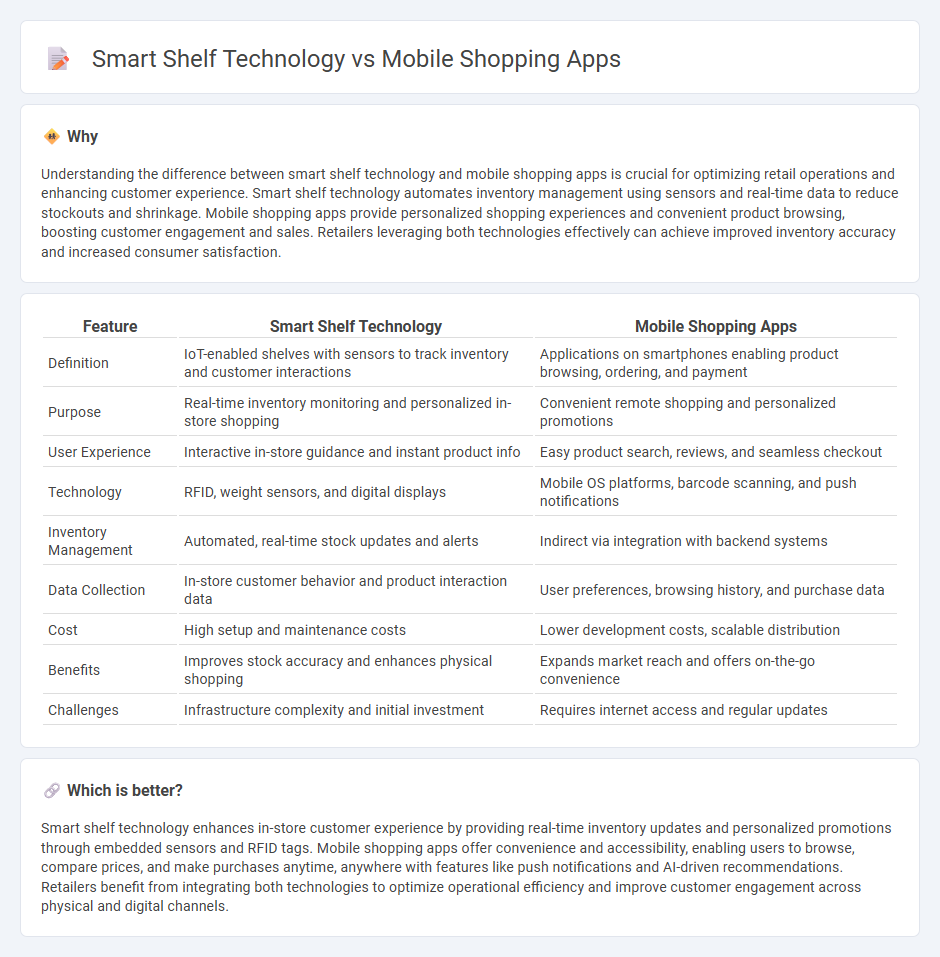
Smart shelf technology revolutionizes inventory management by using RFID sensors and real-time data to ensure product availability and enhance customer experience directly in-store. Mobile shopping apps leverage AI-driven personalization and seamless payment options to provide convenience and tailored recommendations for shoppers anywhere. Explore how these innovations transform retail by bridging physical and digital shopping landscapes.
Why it is important
Understanding the difference between smart shelf technology and mobile shopping apps is crucial for optimizing retail operations and enhancing customer experience. Smart shelf technology automates inventory management using sensors and real-time data to reduce stockouts and shrinkage. Mobile shopping apps provide personalized shopping experiences and convenient product browsing, boosting customer engagement and sales. Retailers leveraging both technologies effectively can achieve improved inventory accuracy and increased consumer satisfaction.
Comparison Table
| Feature | Smart Shelf Technology | Mobile Shopping Apps |
|---|---|---|
| Definition | IoT-enabled shelves with sensors to track inventory and customer interactions | Applications on smartphones enabling product browsing, ordering, and payment |
| Purpose | Real-time inventory monitoring and personalized in-store shopping | Convenient remote shopping and personalized promotions |
| User Experience | Interactive in-store guidance and instant product info | Easy product search, reviews, and seamless checkout |
| Technology | RFID, weight sensors, and digital displays | Mobile OS platforms, barcode scanning, and push notifications |
| Inventory Management | Automated, real-time stock updates and alerts | Indirect via integration with backend systems |
| Data Collection | In-store customer behavior and product interaction data | User preferences, browsing history, and purchase data |
| Cost | High setup and maintenance costs | Lower development costs, scalable distribution |
| Benefits | Improves stock accuracy and enhances physical shopping | Expands market reach and offers on-the-go convenience |
| Challenges | Infrastructure complexity and initial investment | Requires internet access and regular updates |
Which is better?
Smart shelf technology enhances in-store customer experience by providing real-time inventory updates and personalized promotions through embedded sensors and RFID tags. Mobile shopping apps offer convenience and accessibility, enabling users to browse, compare prices, and make purchases anytime, anywhere with features like push notifications and AI-driven recommendations. Retailers benefit from integrating both technologies to optimize operational efficiency and improve customer engagement across physical and digital channels.
Connection
Smart shelf technology enhances inventory accuracy and product visibility by using sensors and RFID tags to track merchandise in real time, which feeds data directly to mobile shopping apps. Mobile apps leverage this information to provide personalized promotions, product availability updates, and seamless in-store navigation, improving the overall shopping experience. The integration of smart shelves and mobile apps enables retailers to optimize stock management and engage customers with timely, relevant offers.
Key Terms
User Experience (UX)
Mobile shopping apps enhance UX through personalized recommendations, seamless navigation, and secure payment options, facilitating convenient and efficient online purchases. Smart shelf technology improves in-store UX by providing real-time product information, dynamic pricing updates, and interactive displays that engage shoppers directly on the retail floor. Explore how these technologies revolutionize consumer interactions by blending digital ease with physical store advantages.
Real-Time Inventory Management
Mobile shopping apps integrate real-time inventory data to update product availability instantly, enhancing the customer shopping experience through accurate stock information. Smart shelf technology uses IoT sensors to monitor inventory levels continuously, enabling automatic stock updates and efficient restocking processes. Explore how these technologies revolutionize retail efficiency and customer satisfaction.
Personalization
Mobile shopping apps leverage user data and AI algorithms to deliver personalized product recommendations and tailored promotions, enhancing customer engagement. Smart shelf technology utilizes real-time sensors and IoT connectivity to provide dynamic pricing and customized in-store experiences based on shopper behavior. Discover how these innovations redefine personalization in retail and boost consumer satisfaction.
Source and External Links
15 Best Shopping Apps in 2025 - MobiLoud - Lists the most popular mobile shopping apps in 2025 including Temu, Shein, Amazon, Walmart, and others, categorized by iOS and Android platforms.
14 Best Shopping Apps of 2025 | Sprout Social - Highlights top shopping apps like Amazon, explaining how they connect shoppers and sellers, offering features such as vast product range, personalized ads, and fast delivery.
The Home Depot Mobile App - Details The Home Depot's app designed for project management, easy shopping with features like image search, barcode scanning, and store navigation to streamline buying for home improvement.
 dowidth.com
dowidth.com